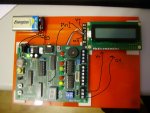robert.higginson
New Member
Hi,
Has any one connected the T4 project board to either an LCD or OLED screen?
I seem to have killed a few off this week.

I connected a LCD screen directly to the test pin point and the +V/0V to the connections at the bottom right corner connections. It worked initially but became fainter with time. Any suggestions of how to test if they have been 'killed' or whether or not I have done something stupid. The backlight still works!
Has any one connected the T4 project board to either an LCD or OLED screen?
I seem to have killed a few off this week.

I connected a LCD screen directly to the test pin point and the +V/0V to the connections at the bottom right corner connections. It worked initially but became fainter with time. Any suggestions of how to test if they have been 'killed' or whether or not I have done something stupid. The backlight still works!

